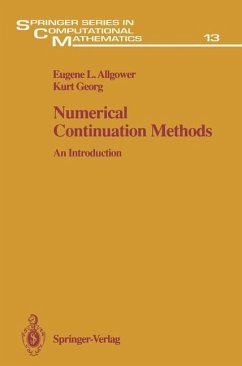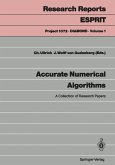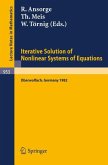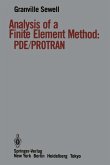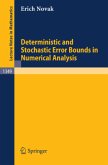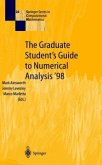- Broschiertes Buch
- Merkliste
- Auf die Merkliste
- Bewerten Bewerten
- Teilen
- Produkt teilen
- Produkterinnerung
- Produkterinnerung
Over the past fifteen years two new techniques have yielded extremely important contributions toward the numerical solution of nonlinear systems of equations. This book provides an introduction to and an up-to-date survey of numerical continuation methods (tracing of implicitly defined curves) of both predictor-corrector and piecewise-linear types. It presents and analyzes implementations aimed at applications to the computation of zero points, fixed points, nonlinear eigenvalue problems, bifurcation and turning points, and economic equilibria. Many algorithms are presented in a pseudo code…mehr
Andere Kunden interessierten sich auch für
![Recent Advances in Iterative Methods Recent Advances in Iterative Methods]() Recent Advances in Iterative Methods77,99 €
Recent Advances in Iterative Methods77,99 €![Accurate Numerical Algorithms Accurate Numerical Algorithms]() Accurate Numerical Algorithms41,99 €
Accurate Numerical Algorithms41,99 €![Iterative Solution of Nonlinear Systems of Equations Iterative Solution of Nonlinear Systems of Equations]() Iterative Solution of Nonlinear Systems of Equations41,99 €
Iterative Solution of Nonlinear Systems of Equations41,99 €![An Oscillation Theorem for Algebraic Eigenvalue Problems and its Applications An Oscillation Theorem for Algebraic Eigenvalue Problems and its Applications]() Frank William SindenAn Oscillation Theorem for Algebraic Eigenvalue Problems and its Applications41,99 €
Frank William SindenAn Oscillation Theorem for Algebraic Eigenvalue Problems and its Applications41,99 €![Analysis of a Finite Element Method Analysis of a Finite Element Method]() Granville SewellAnalysis of a Finite Element Method81,99 €
Granville SewellAnalysis of a Finite Element Method81,99 €![Deterministic and Stochastic Error Bounds in Numerical Analysis Deterministic and Stochastic Error Bounds in Numerical Analysis]() Erich NovakDeterministic and Stochastic Error Bounds in Numerical Analysis21,99 €
Erich NovakDeterministic and Stochastic Error Bounds in Numerical Analysis21,99 €![The Graduate Student's Guide to Numerical Analysis '98 The Graduate Student's Guide to Numerical Analysis '98]() The Graduate Student's Guide to Numerical Analysis '9839,99 €
The Graduate Student's Guide to Numerical Analysis '9839,99 €-
-
-
Over the past fifteen years two new techniques have yielded extremely important contributions toward the numerical solution of nonlinear systems of equations. This book provides an introduction to and an up-to-date survey of numerical continuation methods (tracing of implicitly defined curves) of both predictor-corrector and piecewise-linear types. It presents and analyzes implementations aimed at applications to the computation of zero points, fixed points, nonlinear eigenvalue problems, bifurcation and turning points, and economic equilibria. Many algorithms are presented in a pseudo code format. An appendix supplies five sample FORTRAN programs with numerical examples, which readers can adapt to fit their purposes, and a description of the program package SCOUT for analyzing nonlinear problems via piecewise-linear methods. An extensive up-to-date bibliography spanning 46 pages is included. The material in this book has been presented to students of mathematics, engineering andsciences with great success, and will also serve as a valuable tool for researchers in the field.
Hinweis: Dieser Artikel kann nur an eine deutsche Lieferadresse ausgeliefert werden.
Hinweis: Dieser Artikel kann nur an eine deutsche Lieferadresse ausgeliefert werden.
Produktdetails
- Produktdetails
- Springer Series in Computational Mathematics 13
- Verlag: Springer / Springer Berlin Heidelberg / Springer, Berlin
- Artikelnr. des Verlages: 978-3-642-64764-2
- Softcover reprint of the original 1st edition 1990
- Seitenzahl: 408
- Erscheinungstermin: 1. Oktober 2011
- Englisch
- Abmessung: 235mm x 155mm x 23mm
- Gewicht: 615g
- ISBN-13: 9783642647642
- ISBN-10: 3642647642
- Artikelnr.: 36115379
- Herstellerkennzeichnung Die Herstellerinformationen sind derzeit nicht verfügbar.
- Springer Series in Computational Mathematics 13
- Verlag: Springer / Springer Berlin Heidelberg / Springer, Berlin
- Artikelnr. des Verlages: 978-3-642-64764-2
- Softcover reprint of the original 1st edition 1990
- Seitenzahl: 408
- Erscheinungstermin: 1. Oktober 2011
- Englisch
- Abmessung: 235mm x 155mm x 23mm
- Gewicht: 615g
- ISBN-13: 9783642647642
- ISBN-10: 3642647642
- Artikelnr.: 36115379
- Herstellerkennzeichnung Die Herstellerinformationen sind derzeit nicht verfügbar.
The book provides an introduction to and an up-to-date survey of numerical continuation methods (tracing of implicitly defined curves) of both predictor-corrector and piecewise-linear types. Sample codes with numerical examples are given.
1 Introduction.- 2 The Basic Principles of Continuation Methods.- 2.1 Implicitly Defined Curves.- 2.2 The Basic Concepts of PC Methods.- 2.3 The Basic Concepts of PL Methods.- 3 Newton's Method as Corrector.- 3.1 Motivation.- 3.2 The Moore-Penrose Inverse in a Special Case.- 3.3 A Newton's Step for Underdetermined Nonlinear Systems.- 3.4 Convergence Properties of Newton's Method.- 4 Solving the Linear Systems.- 4.1 Using a QR Decomposition.- 4.2 Givens Rotations for Obtaining a QR Decomposition.- 4.3 Error Analysis.- 4.4 Scaling of the Dependent Variables.- 4.5 Using LU Decompositions.- 5 Convergence of Euler-Newton-Like Methods.- 5.1 An Approximate Euler-Newton Method.- 5.2 A Convergence Theorem for PC Methods.- 6 Steplength Adaptations for the Predictor.- 6.1 Steplength Adaptation by Asymptotic Expansion.- 6.2 The Steplength Adaptation of Den Heijer & Rheinboldt.- 6.3 Steplength Strategies Involving Variable Order Predictors.- 7 Predictor-Corrector Methods Using Updating.- 7.1 Broyden's "Good" Update Formula.- 7.2 Broyden Updates Along a Curve.- 8 Detection of Bifurcation Points Along a Curve.- 8.1 Simple Bifurcation Points.- 8.2 Switching Branches Via Perturbation.- 8.3 Branching Off Via the Bifurcation Equation.- 9 Calculating Special Points of the Solution Curve.- 9.1 Introduction.- 9.2 Calculating Zero Points f(c(s)) = 0.- 9.3 Calculating Extremal Points minsf((c(s)).- 10 Large Scale Problems.- 10.1 Introduction.- 10.2 General Large Scale Solvers.- 10.3 Nonlinear Conjugate Gradient Methods as Correctors.- 11 Numerically Implementable Existence Proofs.- 11.1 Preliminary Remarks.- 11.2 An Example of an Implementable Existence Theorem.- 11.3 Several Implementations for Obtaining Brouwer Fixed Points.- 11.4 Global Newton and Global Homotopy Methods.- 11.5Multiple Solutions.- 11.6 Polynomial Systems.- 11.7 Nonlinear Complementarity.- 11.8 Critical Points and Continuation Methods.- 12 PL Continuation Methods.- 12.1 Introduction.- 12.2 PL Approximations.- 12.3 A PL Algorithm for Tracing H(u) = 0.- 12.4 Numerical Implementation of a PL Continuation Algorithm.- 12.5 Integer Labeling.- 12.6 Truncation Errors.- 13 PL Homotopy Algorithms.- 13.1 Set-Valued Maps.- 13.2 Merrill's Restart Algorithm.- 13.3 Some Triangulations and their Implementations.- 13.4 The Homotopy Algorithm of Eaves & Saigal.- 13.5 Mixing PL and Newton Steps.- 13.6 Automatic Pivots for the Eaves-Saigal Algorithm.- 14 General PL Algorithms on PL Manifolds.- 14.1 PL Manifolds.- 14.2 Orientation and Index.- 14.3 Lemke's Algorithm for the Linear Complementarity Problem.- 14.4 Variable Dimension Algorithms.- 14.5 Exploiting Special Structure.- 15 Approximating Implicitly Defined Manifolds.- 15.1 Introduction.- 15.2 Newton's Method and Orthogonal Decompositions Revisited.- 15.3 The Moving Frame Algorithm.- 15.4 Approximating Manifolds by PL Methods.- 15.5 Approximation Estimates.- 16 Update Methods and their Numerical Stability.- 16.1 Introduction.- 16.2 Updates Using the Sherman-Morrison Formula.- 16.3 QR Factorization.- 16.4 LU Factorization.- P1 A Simple PC Continuation Method.- P2 A PL Homotopy Method.- P3 A Simple Euler-Newton Update Method.- P4 A Continuation Algorithm for Handling Bifurcation.- P5 A PL Surface Generator.- P6 SCOUT - Simplicial Continuation Utilities.- P6.1 Introduction.- P6.2 Computational Algorithms.- P6.3 Interactive Techniques.- P6.4 Commands.- P6.5 Example: Periodic Solutions to a Differential Delay Equation.- Index and Notation.
1 Introduction.- 2 The Basic Principles of Continuation Methods.- 2.1 Implicitly Defined Curves.- 2.2 The Basic Concepts of PC Methods.- 2.3 The Basic Concepts of PL Methods.- 3 Newton's Method as Corrector.- 3.1 Motivation.- 3.2 The Moore-Penrose Inverse in a Special Case.- 3.3 A Newton's Step for Underdetermined Nonlinear Systems.- 3.4 Convergence Properties of Newton's Method.- 4 Solving the Linear Systems.- 4.1 Using a QR Decomposition.- 4.2 Givens Rotations for Obtaining a QR Decomposition.- 4.3 Error Analysis.- 4.4 Scaling of the Dependent Variables.- 4.5 Using LU Decompositions.- 5 Convergence of Euler-Newton-Like Methods.- 5.1 An Approximate Euler-Newton Method.- 5.2 A Convergence Theorem for PC Methods.- 6 Steplength Adaptations for the Predictor.- 6.1 Steplength Adaptation by Asymptotic Expansion.- 6.2 The Steplength Adaptation of Den Heijer & Rheinboldt.- 6.3 Steplength Strategies Involving Variable Order Predictors.- 7 Predictor-Corrector Methods Using Updating.- 7.1 Broyden's "Good" Update Formula.- 7.2 Broyden Updates Along a Curve.- 8 Detection of Bifurcation Points Along a Curve.- 8.1 Simple Bifurcation Points.- 8.2 Switching Branches Via Perturbation.- 8.3 Branching Off Via the Bifurcation Equation.- 9 Calculating Special Points of the Solution Curve.- 9.1 Introduction.- 9.2 Calculating Zero Points f(c(s)) = 0.- 9.3 Calculating Extremal Points minsf((c(s)).- 10 Large Scale Problems.- 10.1 Introduction.- 10.2 General Large Scale Solvers.- 10.3 Nonlinear Conjugate Gradient Methods as Correctors.- 11 Numerically Implementable Existence Proofs.- 11.1 Preliminary Remarks.- 11.2 An Example of an Implementable Existence Theorem.- 11.3 Several Implementations for Obtaining Brouwer Fixed Points.- 11.4 Global Newton and Global Homotopy Methods.- 11.5Multiple Solutions.- 11.6 Polynomial Systems.- 11.7 Nonlinear Complementarity.- 11.8 Critical Points and Continuation Methods.- 12 PL Continuation Methods.- 12.1 Introduction.- 12.2 PL Approximations.- 12.3 A PL Algorithm for Tracing H(u) = 0.- 12.4 Numerical Implementation of a PL Continuation Algorithm.- 12.5 Integer Labeling.- 12.6 Truncation Errors.- 13 PL Homotopy Algorithms.- 13.1 Set-Valued Maps.- 13.2 Merrill's Restart Algorithm.- 13.3 Some Triangulations and their Implementations.- 13.4 The Homotopy Algorithm of Eaves & Saigal.- 13.5 Mixing PL and Newton Steps.- 13.6 Automatic Pivots for the Eaves-Saigal Algorithm.- 14 General PL Algorithms on PL Manifolds.- 14.1 PL Manifolds.- 14.2 Orientation and Index.- 14.3 Lemke's Algorithm for the Linear Complementarity Problem.- 14.4 Variable Dimension Algorithms.- 14.5 Exploiting Special Structure.- 15 Approximating Implicitly Defined Manifolds.- 15.1 Introduction.- 15.2 Newton's Method and Orthogonal Decompositions Revisited.- 15.3 The Moving Frame Algorithm.- 15.4 Approximating Manifolds by PL Methods.- 15.5 Approximation Estimates.- 16 Update Methods and their Numerical Stability.- 16.1 Introduction.- 16.2 Updates Using the Sherman-Morrison Formula.- 16.3 QR Factorization.- 16.4 LU Factorization.- P1 A Simple PC Continuation Method.- P2 A PL Homotopy Method.- P3 A Simple Euler-Newton Update Method.- P4 A Continuation Algorithm for Handling Bifurcation.- P5 A PL Surface Generator.- P6 SCOUT - Simplicial Continuation Utilities.- P6.1 Introduction.- P6.2 Computational Algorithms.- P6.3 Interactive Techniques.- P6.4 Commands.- P6.5 Example: Periodic Solutions to a Differential Delay Equation.- Index and Notation.

